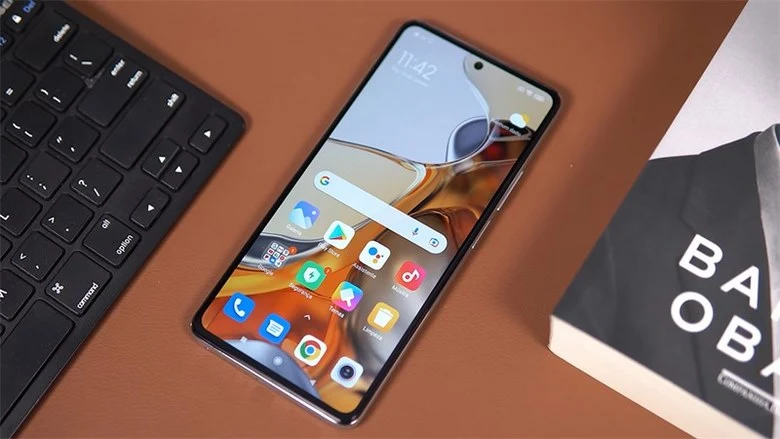On the one hand, we have Oppo, which has established itself as one of the best Android smartphone manufacturers with the Find X5 Pro. It competes with the best phones of the moment and manages to take some risks in the process. And on the other the successor of the flagship Xiaomi 12 Pro, which is equipped with a very high resolution main camera sensor. How do these two smartphones compare?
Oppo Find X5 Pro vs Xiaomi 12T Pro: Screen and design
| Oppo Find X5 Pro | XIAOMI 12T PRO | |
|---|---|---|
 | $929.00 | $574.50 |


Oppo has equipped the Find X5 Pro with a ceramic back that features a high-gloss finish. It features the usual array of touches of a flagship phone, such as an IP68 rating for some form of water resistance and a high-end finish. The camera bump almost blends into the body, while the Gorilla Glass Victus display curves around the edges. The finish is very smooth and the grip is very pleasant.
At a pre-release briefing, Oppo representatives said that the Find X5 Pro has a slightly modified camera module compared to the Find X3 Pro. The module has been moved up slightly, supposedly so that your fingers don’t impinge on the camera lenses.
The 6.7-inch Find X5 Pro 1440p OLED display is colorful and rich, with perfect blacks and plenty of brightness for outdoor use. Put it next to the Galaxy S22 Ultra and it’s not quite as bright when watching HDR videos on Netflix, but I can’t imagine many will notice the difference unless you have both phones next to each other.


The Xiaomi 12T Pro is obviously a continuity candidate to succeed the Xiaomi 12 Pro, as it is very similar. While the Xiaomi 12 Pro has Gorilla Glass Victus on the front, the 12T Pro on the other hand has Gorilla Glass 5, so you might not get the same level of resistance, and it also lacks an IP rating, so we can’t be sure how it can react to water or dust exposure.
The screen is very accomplished, and ranks among the best features of the Xiaomi 12T Pro. This AMOLED panel offers excellent contrast with over 68 billion colors and HDR10+, and its 1220x27127p resolution is very sharp and does justice to the content. Plus, if you watch videos that support HDR10+, you’ll notice that the colors are even more vibrant.
Oppo Find X5 Pro vs Xiaomi 12T cameras


In many ways, the Oppo Find X5 Pro’s camera is one of the most capable out there. Both the wide and ultra-wide arrays take fantastic shots, full of rich, vibrant color in all sorts of situations.
The phone has excellent stabilization, both by three-axis sensor movement and two-axis lens movement, which allows for longer exposures in poor conditions. Take this phone out to a dark bar and you’ll see less blurry results, even compared to the Samsung Galaxy S22 Ultra.
The latest rear camera is a 13-megapixel (with an f/2.4 lens) and it is used for zooming. There is no periscope technology inside and it just seems to crop the images a bit more. The results are good but not up to the Galaxy S22 Ultra and not even as good as Oppo’s 2019 effort. There’s also a 32MP camera on the front that can move between 80 and 90 degree views depending on how many faces you’re trying to cram in.
Video can be shot at up to 4K 60fps and stabilization skills make for stable footage. There’s even a 4K Ultra night video mode that Oppo says can shoot at 5 lux, which is very, very dark. Perhaps the most important feature of the Xiaomi 12T Pro is the incredibly high resolution of its main camera, which reaches 200 megapixels.


However, the overall picture is not necessarily a clear upgrade from its predecessor the Xiaomi 12 Pro offered excellent versatility through three lenses, each with a strong resolution of 50 megapixels, while the approach with this device has clearly been to emphasize the main sensor perhaps at the expense of the others, as it is accompanied by an ultra-wide 8-megapixel sensor and a 20-megapixel macro sensor.
The main sensor, which measures 1/1.22 inch, offers many possibilities. It has a built-in 2x sensor zoom that’s primarily intended for taking strong portrait photos, it can take 8K resolution video (at 24fps), and there are some software optimizations as well.
Which one performs better?


The Find X5 Pro comes with high-end specs that you will see on many phones. The phone features a 4nm Snapdragon 8 Gen 1 chipset, 12GB of RAM, 256GB of storage and a bulky vapor chamber to disperse heat.
Larger cooling systems seem to be a theme with 2022 high-end phones so far, likely due to the 8 Gen 1 chip running pretty hot.
The Snapdragon 8 Gen 1 chip hasn’t been around very long, with the Find X5 Pro being one of the first high-end phones to use it. The 4nm build is there to improve efficiency, and while there are some performance gains over the outgoing Snapdragon 888, they’re pretty minimal. Oppo’s Android ColorOS layer has improved so much in the last few years.


The Xiaomi 12T Pro also runs on Qualcomm’s latest and greatest mobile processor, namely the Snapdragon 8 Plus Gen 1 and the software on board the Xiaomi 12T Pro is MIUI 13, which is built on Android 12.
Which one has the best battery life?


5000mAh has become the battery size of choice for 2022 flagships. Unless you’re getting into heavy gaming and hammering the screen with high-brightness HDR videos, the Find X5 Pro can easily last all day and then the second day, so if you tweak the settings, you can certainly stretch it further.
The important thing is that when the phone starts to get into the red, it won’t take long to get back to 100%. The iPhone 13 Pro Max may be more enduring, but the Find X5 Pro’s 80-watt charge takes it from 0 to 100 percent in just over 30 minutes, and a 15-minute charge will get you over 50 percent.
Oppo is confident that these faster speeds won’t degrade the battery any faster either, as it said the phone should last over 1600 charge cycles. Considering you’ll be recharging the phone once a day, that should easily last for the duration of the contract with a healthy battery.
| Oppo Find X5 Pro | XIAOMI 12T PRO | |
|---|---|---|
   | $929.00 | $574.50 |


The battery capacity of the 12T Pro is very encouraging, weighing in at 5000mAh. That’s a hefty size, and usually Android phones offer a good day’s worth of battery life with such a cell on board. It’s worth noting that it’s at least larger than the Xiaomi 12 Pro, which was 4600mAh.
The charging prowess of this phone is at least as impressive as its battery capacity. With 120W of power, Xiaomi claims that the phone can go from 0 to 100% battery in just 19 minutes, which is an amazing speed that would leave the iPhone 13 and Samsung Galaxy S22 far in the shade. This feature is a great boost when you need to quickly charge your phone before going out, especially if you forgot to charge it overnight. However, the downside of this benefit is that the Xiaomi 12T Pro does not support wireless charging.
Also find out :
- Oppo Find X5 Pro vs Oppo Reno 8 Pro: which one to choose
- Iphone 14 Pro vs Oppo Find X5 Pro: which is the best?
